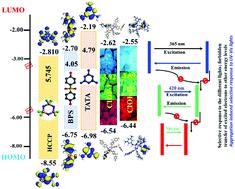当前位置:
X-MOL 学术
›
J. Mater. Chem. C
›
论文详情
Our official English website, www.x-mol.net, welcomes your
feedback! (Note: you will need to create a separate account there.)
Amorphous covalent inorganic–organic hybrid frameworks (CIOFs) with an aggregation induced selective response to UV–Visible light and their DFT studies
Journal of Materials Chemistry C ( IF 5.7 ) Pub Date : 2020-08-31 , DOI: 10.1039/d0tc01535k Majid Basharat 1, 2, 3 , Yasir Abbas 1, 2, 3 , Djebar Hadji 4, 5, 6, 7 , Zahid Ali 1, 2, 3 , Shuangkun Zhang 1, 2, 3 , Hanlin Ma 1, 2, 3 , Zhanpeng Wu 1, 2, 3 , Wei Liu 2, 3, 8
Journal of Materials Chemistry C ( IF 5.7 ) Pub Date : 2020-08-31 , DOI: 10.1039/d0tc01535k Majid Basharat 1, 2, 3 , Yasir Abbas 1, 2, 3 , Djebar Hadji 4, 5, 6, 7 , Zahid Ali 1, 2, 3 , Shuangkun Zhang 1, 2, 3 , Hanlin Ma 1, 2, 3 , Zhanpeng Wu 1, 2, 3 , Wei Liu 2, 3, 8
Affiliation

|
Covalent inorganic–organic hybrid frameworks (CIOFs) composed of inorganic heterocycles covalently linked to organic building blocks are a relatively unexplored and fertile area of research compared to the covalent organic frameworks. Herein, we report the selective light responsive CIOFs prepared by considering energy gaps (Egs) of the inorganic heterocycle (P3N3Cl6) (Eg 5.745 eV), organic building block (4,4-sulfonyldiphenol) (Eg 4.05 eV), and triazine heterocycle (1,3,5-triazine-2,4,6-triamine) (Eg 4.79 eV) under mild reaction conditions (by P–O–C and P–NH–C bond formation). The morphology of CIOF-I (prepared from hexachlorocyclotriphosphazene and 4,4-sulfonyldiphenol) is micro-spherical (diameter, ca. 0.6–1 μm), whereas that of CIOF-II (prepared from hexachlorocyclotriphosphazene and 1,3,5-triazine-2,4,6-triamine) is micro-spherical (diameter, ca. 0.5–1 μm) as well as tubular. The X-ray diffraction (XRD) analysis showed that these CIOFs are amorphous in nature. The luminescence studies of both CIOFs have shown a selective response to different lights; when excited under UV light at a wavelength of 365 nm, the CIOFs showed cyan emission, while under visible region 420 nm and 546 nm excitations, the emission shifts to green and red, respectively. CIOF-I demonstrated maximum emission at 454 nm (Ex. 365 nm), 487 nm (Ex. 420 nm), and 708 nm (Ex. 546 nm), while CIOF-II exhibited maximum emission at 460 nm (Ex. 365 nm), 478 nm (Ex. 420 nm), and 604 nm (Ex. 546 nm). The density functional theory (DFT) studies were performed based on Gaussian 09 (B3LYP/6-311+G (d,p)) for the core structure of CIOFs’ HOMO and LUMO levels (CIOF-I −6.54 eV, −2.62 eV and CIOF-II −6.44 eV, −2.55 eV), and Egs (3.92 eV and 3.84 eV) which are in good agreement with the experimental values. The mechanism behind the demonstration of similar emission colors by two different chemical structures is also underpinned. The selective response towards different lights is ascribed to the aggregation/clustering-induced/triggered emission (AIE/CTE) and restricted rotation emission (RRE) due to the crosslinking of the wider energy gap inorganic heterocycle and organic linkers. This study may grab the attention of researchers to study the inorganic heterocycle centered selective light responsive materials due to their extensive application prospects.
更新日期:2020-10-16











































 京公网安备 11010802027423号
京公网安备 11010802027423号